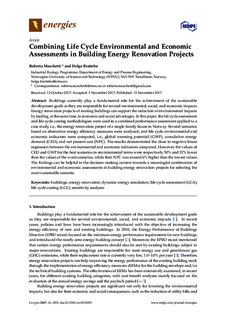| dc.contributor.author | Moschetti, Roberta | |
| dc.contributor.author | Brattebø, Helge | |
| dc.date.accessioned | 2018-08-24T12:21:31Z | |
| dc.date.available | 2018-08-24T12:21:31Z | |
| dc.date.created | 2018-02-17T11:19:01Z | |
| dc.date.issued | 2017 | |
| dc.identifier.citation | Energies. 2017, 10 (11), 1-17. | nb_NO |
| dc.identifier.issn | 1996-1073 | |
| dc.identifier.uri | http://hdl.handle.net/11250/2559261 | |
| dc.description.abstract | Buildings currently play a fundamental role for the achievement of the sustainable development goals as they are responsible for several environmental, social, and economic impacts. Energy renovation projects of existing buildings can support the reduction of environmental impacts by leading, at the same time, to economic and social advantages. In this paper, the life cycle assessment and life cycle costing methodologies were used in a combined performance assessment applied to a case study, i.e., the energy renovation project of a single-family house in Norway. Several scenarios based on alternative energy efficiency measures were analyzed, and life cycle environmental and economic indicators were computed, i.e., global warming potential (GWP), cumulative energy demand (CED), and net present cost (NPC). The results demonstrated the close to negative linear regression between the environmental and economic indicators computed. However, the values of CED and GWP for the best scenarios in environmental terms were respectively 50% and 32% lower than the values of the worst scenarios, while their NPC was around 6% higher than the lowest values. The findings can be helpful in the decision-making context towards a meaningful combination of environmental and economic assessments in building energy renovation projects for selecting the most sustainable scenario. | nb_NO |
| dc.language.iso | eng | nb_NO |
| dc.publisher | MDPI | nb_NO |
| dc.rights | Navngivelse 4.0 Internasjonal | * |
| dc.rights.uri | http://creativecommons.org/licenses/by/4.0/deed.no | * |
| dc.title | Combining life cycle environmental and economic assessments in building energy renovation projects | nb_NO |
| dc.type | Journal article | nb_NO |
| dc.type | Peer reviewed | nb_NO |
| dc.description.version | publishedVersion | nb_NO |
| dc.source.pagenumber | 1-17 | nb_NO |
| dc.source.volume | 10 | nb_NO |
| dc.source.journal | Energies | nb_NO |
| dc.source.issue | 11 | nb_NO |
| dc.identifier.doi | 10.3390/en10111851 | |
| dc.identifier.cristin | 1566208 | |
| dc.description.localcode | © 2017 by the authors. Licensee MDPI, Basel, Switzerland. This article is an open access article distributed under the terms and conditions of the Creative Commons Attribution (CC BY) license (http://creativecommons.org/licenses/by/4.0/). | nb_NO |
| cristin.unitcode | 194,64,25,0 | |
| cristin.unitname | Institutt for energi- og prosessteknikk | |
| cristin.ispublished | true | |
| cristin.fulltext | original | |
| cristin.qualitycode | 1 | |

